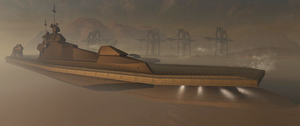| Crassus-class | |||||||||||
|---|---|---|---|---|---|---|---|---|---|---|---|

| |||||||||||
| Class attributes | |||||||||||
|
Operators: |
| ||||||||||
|
Manufacturer: |
|||||||||||
|
In service: |
|||||||||||
| |||||||||||
The Crassus-class supercarrier is a class of large seaborne warship manufactured by SinoViet Heavy Machinery and fielded by various human military forces on Earth.[1]
Overview
Design details
The Crassus-class supercarrier is a large aircraft carrier that features two runways and two towers atop the flight deck,[3] with one being the air control tower.[1] The Crassus-class's interior corridors are known to be particularly cramped.[1] Below the flight deck, the carrier features spacious interior hangar bays, with at least one accessible via a large ramp at water-level. The Crassus-class is notably a multihull vessel similar to a catamaran, with one hull running the length of the carrier's main beam and another smaller hull section beneath the extended angled runway.[3]
Complement
While the Crassus-class is not known to feature any of its own armaments, it has been seen stocked with Pelican dropships and F-99 Wombat drones.[1][3]
Development history
The Crassus-class supercarrier was manufactured by SinoViet Heavy Machinery and entered service in 2411.[1]
Ships of the line
- UNSC Crassus - the lead ship of the class.
- At least one other vessel[4]
Operational history
At least one Crassus-class supercarrier served within regional defensive forces of the East African Protectorate after its commissioning in 2411. This ship acted as a training vessel and mothership for drones throughout the remainder of the century—being retired from service in 2490 to serve as a floating museum ship. However, the Crassus would be reactivated and appropriated by the United Nations Space Command in 2550 as part of the preparations for the Covenant's inevitable attack on Earth.[1]
At least two Crassus-class supercarriers,[5] including the UNSC Crassus itself,[1] took part in the Battle of Mombasa on October 20, 2552.[5] These vessels deployed F-99 Wombat UCAVs and Pelican dropships to provide surveillance and air strikes against the Covenant, supporting scattered UNSC Marines and New Mombasa Police Department personnel from around the Mombasa Quays.[5][1]
On November 18, 2552, the UNSC Crassus and its escorts were spotted by Jiralhanae hunting parties, resulting in the carrier being boarded. The Covenant boarding parties attacked the ship using war-sleds and dropships, and were able to quickly seize the ship's flight decks before proceeding to conduct close-quarters boarding attempts inside the ship's cramped interior passageways. Ultimately, the smaller stature of the human crew proved a boon in the battle, as the narrow bulkheads were unwieldly for the tall Jiralhanae and wide Unggoy to effectively move in. As such, the Covenant attack was quickly faltered, with the commanding Brutes electing to retreat to their dropships and destroy the carrier's air control tower. Following this, the damaged UNSC Crassus was towed to Durban and decommissioned and utilized as a museum ship once more.[1]
Production notes
During Halo 3's development, the UNSC was going to have a "wet NAVY" that included an aircraft carrier, presumably a Crassus-class supercarrier like those visible on Longshore.[6]
Gallery
Development images
Screenshots
A comparison between the UNSC Forward Unto Dawn and the carrier.
List of appearances
- Halo 3
- Mythic II Map Pack (First appearance)
Sources
- ^ a b c d e f g h i j k l m n o p q Halo Waypoint, Canon Fodder - Ship Strike (Retrieved on Apr 20, 2023) [archive]
- ^ Halo Encyclopedia (2022 edition), page 60-61
- ^ a b c d Halo 3, Aircraft carrier model
- ^ Halo 3, multiplayer map Longshore: Two supercarriers are docked outside the map. Assuming at least one is the Crassus, this means there is at least one more vessel of the class.
- ^ a b c Halo 3, campaign level Longshore
- ^ The Art of Halo 3, page 37
| ||||||||||||||||||||||||||||||||||||||||||||||||||||||||
